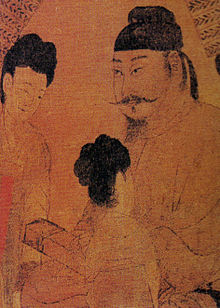Tang Taizong

The Tang Emperor Taizong ( Chinese 唐太宗 , Pinyin Táng Tàizōng ; * January 23, 599 , † July 10, 649 ) was one of the most important rulers of China. He ruled from 626 to 649.
Taizong was the son of Lǐ Yuān ; its original name was Lǐ Shìmín ( 李世民 ). He was behind many of his father's successes and was already in command of his father's troops during the conquest of Chang'an (617) and the resulting fall of the Sui dynasty . In 621, Li Shimin defeated the warlords Dou Jiande and Wang Shichong , the last important opponents of his father. As a reward, Li Yuan, who had assumed the emperor name Gaozu, made him civil and military governor of the eastern plains. Li Shimin soon began expanding his headquarters in Luoyang . Its advisory staff consisted of experienced officers and officials. He also had an academy built in Luoyang.
This led to a bitter argument between him and the actual Crown Prince Li Jiancheng , in which his father gave him insufficient protection. In July 626, Li Shimin personally murdered the Crown Prince in a scuffle at the Xuanwumen Gate, the entrance to the Imperial Palace that he had occupied with his supporters. One of his aides killed a younger brother. The sons of the two princes were murdered, the people were delighted with a general amnesty and temporary tax breaks, and his father was forced to abdicate.
In the same year moved Göktürks under the Khan Xieli (r. 619-630) in order to collect tribute. At the end of September 626 he was standing in front of the Chinese capital with supposedly 100,000 men. Emperor Taizong rejected the proposal to entrench himself with his few troops in the capital and attacked the Khan offensively on the Wei River (Bian Bridge). His bluff succeeded, and Xieli withdrew; In 629/30 he was finally deposed and captured by Chinese troops.
Taizong was considered far-sighted and just. As emperor, he limited the ambition of his aristocratic troop leaders through constant employment and maneuvers. He preferred to appoint military men of low origin and only gave them temporary commands, e.g. B. on the northern borders. His father, Emperor Gaozu , had inflated the administration in order to satisfy as many former rebel leaders from the time of the change of dynasty with administrative posts. With the Tang's power secured, Taizong was able to reorganize and streamline the administration. To this end, he also made the examination system for civil servants mandatory, so that a maximum of 10% of the candidates passed the tests.
Although he was not a great friend of Buddhism , Taizong received the well-traveled monk Xuanzang at court. In 636 AD he received the Nestorian Christian Olopön . He had his Christian writings translated into Chinese and examined the teachings in his private chambers. Finally, he ordered that they should be preached and shared. He was a promoter of Christian doctrine, and on his orders a magnificent church was built in 638 in Sianfu . Churches also sprang up in other cities. Christianity flourished in China for the next two centuries, until it was almost completely wiped out as a result of the severe persecution of Christians and Buddhists and the destruction of churches under Emperor Wuzong (841–846).
In Taizong's final years in government there was alienation from his advisers, who disapproved of his constant wars.
literature
- Otto Franke : History of the Chinese Empire . Volume 2. De Gruyter, Berlin / Leipzig 1936.
- Mark Edward Lewis: China's Cosmopolitan Empire. The Tang Dynasty. Belknap, London / Cambridge (Massachusetts) 2009.
- Denis C. Twitchett, John K. Fairbank (Eds.): The Cambridge History of China, Vol. 3. Sui and T'ang China, 589-906. Cambridge University Press, Cambridge 1979, ISBN 0-521-21446-7 .
Web links
| predecessor | Office | successor |
|---|---|---|
| Gaozu |
Emperor of China 626–649 |
Gaozong |
| personal data | |
|---|---|
| SURNAME | Tang Taizong |
| ALTERNATIVE NAMES | Li Shimin |
| BRIEF DESCRIPTION | Chinese Emperor of the Tang Dynasty |
| DATE OF BIRTH | January 23, 599 |
| DATE OF DEATH | July 10, 649 |